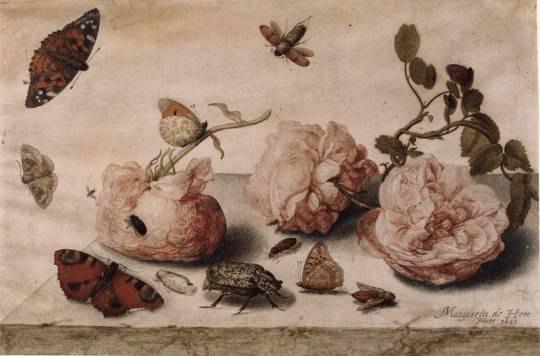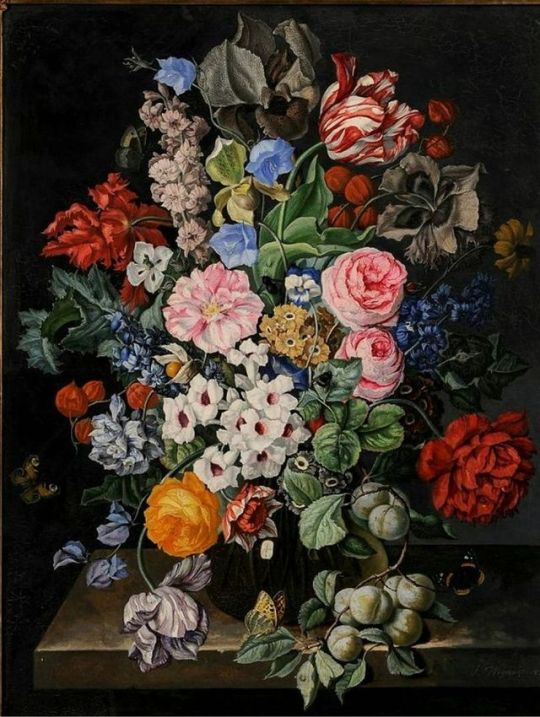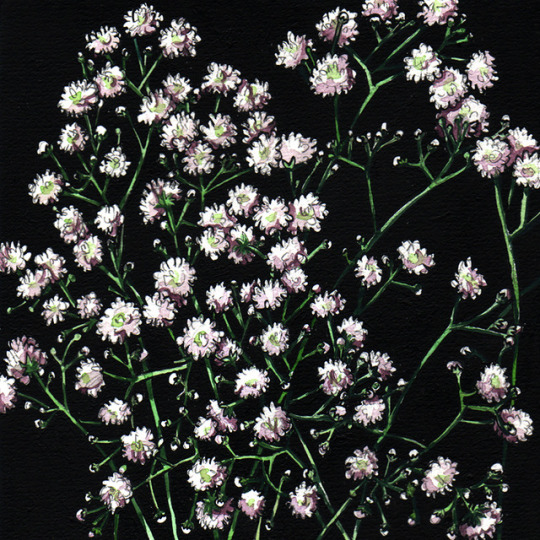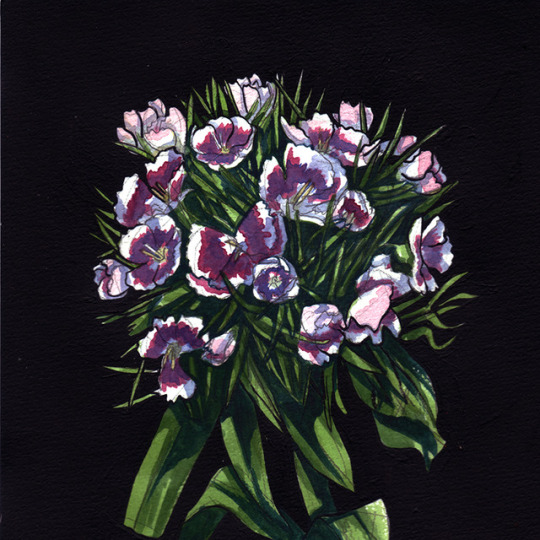Weekly blog revealing the hidden historical meanings of plants and flowers, accompanied by detailed illustrations. Text and illustrations by Mira Gryseels.
Don't wanna be here? Send us removal request.
Note
This post has the wrong species name. You've listed the Cardoon (Artichoke thistle, Cynara cardunculus ) in error. The correct species for the globe artichoke is Cynara scolymus. A very significant error that your readership has continued. [post/163806218186/artichoke-cynara-cardunculus-desire-it-wont ]
Sorry it took me so long, it’s fixed now!
11 notes
·
View notes
Photo

The Ass in the School, 1556, Pieter Bruegel the Elder
Medium: pen,indianink
88 notes
·
View notes
Note
I've just recently gotten back into Floriography and found your art and just wanted to tell you it's all so lovely and keep up the good work!
Oh, thank you! I haven’t updated in so, so long, so I haven’t really been keeping up the good work... life and mental health and art block got in the way, as it tends to do. I lost my studio space, and my motivation to find and spend large parts of my income on another one. It’s been almost two years now... I think I might like to continue once I move (hopefully soon) and have actual, real desk space to draw and work from. If anyone is still actively following this blog, feel free to send me some recommendations for flowers and plants I can research! I’m not going to make any promises for a big blog revival though, because the pressure is part of what got me depressed and burnt out in the first place... I want to be able to do things for fun again.
20 notes
·
View notes
Note
hello, could I use your texts translated to polish in a Wattpad book if I give you credit?
Hi, I’m sorry I haven’t looked at this blog in a while (i haven’t left permanently, am just completely swamped for a While) and I don’t know when this was asked, but yes you can do this! If you wouldn’t mind, can you send me a link when it’s done? I don’t speak polish but it would be nice to have for future reference.
To anyone else who wants to reference my work: as long as it’s with credit, and you ask me beforehand, I’ll usually be okay with it! DO NOT publish me in anything without my consent, though, ever.
4 notes
·
View notes
Photo




Wie kan hier all’ de wondren tellen?
Ik zie de purpren Muskadellen;
‘k Zie de adertjes der blaadjes zwellen,
Door milde morgendauw besproeid.
De schoone Pruim en Perzik bloozen;
Terwijl het Violiertje gloeit
In schaaûw van witte en roode Roozen.
My dunkt ik zie dat Rupsje weeven,
Dat Bytje door de takjes zweeven,
Noem dit geen kunst: o neen : ‘t is leven.
(Who can count these wonders all?
I see the purple Muscatel;
I see the leaves’ veins as they swell
Under the gentle morning dew.
The Plum and Peach, they blush, ‘tis said,
and fragrant Stock of glowing hue,
shaded by Roses white and red.
The caterpillar wends its way,
Methinks that bee above doth sway,
Call not this art: ‘tis life, I say.)
-Lukretia Wilhelmina van Merken, in honour of Rachel Ruysch’s oeuvre (1750)
On this International Women’s Day, I’d like to highlight some of my greatest heroes and inspirations: the women whose fantastic works shaped the Dutch Golden Age. The harmful and disrespectful notion that women artists didn’t exist in history (and if they did, they were never successful) persists to this day. I want to stress, desperately, that this is not so. Women’s labour throughout the ages has been tragically undervalued, and women’s art has been systematically pushed aside and labelled as “kitsch” and “craft” by those who would have women make nothing else.
Margareta de Heer, Clara Peeters, Rachel Ruysch and Maria van Oosterwijck were each very achieved artists, and their work was heavily sought after in their time. With the limitations set upon them by society - still life was the only form of painting a (wealthy) woman could do at the time - they built great careers and lasting legacies. Their love of the natural world shows in the beautiful, detailed way they depict it in their work, and if ever you are blessed with the opportunity to see any of it in real life, I strongly suggest you do so. They are the giants whose shoulders we stand on, and must never be forgotten.
281 notes
·
View notes
Photo

Milkweed (Asclepia) - sorrowful remembrance
Who was Asclepius? In Greek mythology, he was the son of Apollo. His mother Coronis was killed by Artemis (as ordered by her brother) for having an affair with a human man. Apollo performed the world’s first Cesaerean section on the dead body burning on the pyre, and raised Asclepius with the help of the centaur Chiron.
Asclepius became fantastically skilled in medicine, and developed powerful potions based on Gorgon blood. He became famous for curing snakebites, and the Rod of Asclepius - a staff with a snake wrapped around it — is a symbol of medicine to this day. At the height of his powers, Asclepius was able to raise the dead, which is never a good idea around Greek Gods. Hades complained to Zeus, who struck down Asclepius with a mighty lightning bolt. Afterwards, he had to begrudgingly admit that Asclepius had achieved incredible things, and turned him into a constellation for his efforts.
What is truly interesting about the Milkweed as a flower is that it “bites” into the insects that land on it: it attaches itself to its feet or mouth, and the bug will have to pull off the pollen sacs and carry it with them to get free. Perhaps this reminded Carolus Linnaeus of a snake, causing him to name it after the demigod they represent.
(illustration and writing by Mira Gryseels)
#asclepias#milkweed#greek mythology#artists on tumblr#floriography#botanical illustration#botanical art#illustration#watercolor#watercolour#painting#language of flowers#flower language#symbolism#mythology#asclepius#flower symbolism#watercolor painting#watercolour illustration#history
237 notes
·
View notes
Photo

Baby’s Breath (Gypsophila paniculata) - true love, pure heart
It is odd to see baby’s breath by itself, common as it is in so many bouquets as the visual support of a fuller, more impressive flower. Not that it isn’t beautiful in its own right, but baby breath’s fine lace adds a classically delicate and immortally stylish lining to a rose’s deep red velvet.
Baby’s Breath loves. It loves the calcium-rich ground it grows in, and the sun it grows to. It loves Chicago, where it is classified as an invasive species, maybe a little too much. It loves the other flowers in the bouquet, supporting them without taking the attention for itself. It has been in more wedding bouquets than probably any other flower, its mess of pure white button flowers as symbols for the pure mess of love in the hearts of the betrothed couple. To some, the flower might be a little bit old-fashioned, but it’s a staple for a reason.
(illustration and writing by Mira Gryseels)
#floriography#language of flowers#painting#botanical illustration#artists on tumblr#baby's breath#gypsophila paniculata#floral symbolism#flower meaning#flower language#illustration#watercolor illustration#watercolour#watercolor#watercolour painting#true love#symbolism
283 notes
·
View notes
Photo

Sweet William (Dianthus Barbatus) - gallantry
Once upon a time, Margaret may have seen William through the window while dreamily combing her hair, as he marched in a wedding procession next to his new bride who, sadly, was not Margaret. Or William might have died on a distant shore, and appeared before Margaret as a ghost to say goodbye. Or perhaps it was Margaret who perished, and William who saw her vision. In any case, someone dies of heartbreak and becomes a ghost in this story, and appears before the other to beg a sweet farewell. The other promptly dies as well and, and they are joined in posthumous love.
This type of death-transcending love between a man and a woman is a persistent theme in romantic legend- this collection of Scottish songs (Fair Margaret and Sweet William, Sweet William’s Ghost, The Unquiet Grave, Barbara Allen) houses some of the most beautiful and touching examples, and a quick search will provide you a wide variety of old and new interpretations.
Sweet William, as a flower, is a gorgeous dense cluster of white and pink that buzzes with life, as it is attractive not only to the human eye but to those of birds and insects as well. It is great in flower arrangements as well as gardens that burst with sweet colours and smells. As this subspecies of the Dianthus genus is a symbol of heterosexual romantic love, you’ll find its sibling, the carnation, being a symbol for homosexual affections.
(writing and illustration by Mira Gryseels)
#sweet william#floriography#language of flowers#artists on tumblr#botanical art#art#dianthus#dianthus barbatus#scotland#mythology#symbolism#flower language#floral symbolism#painting#watercolor#watercolour#illustration
123 notes
·
View notes
Photo

Happy holidays everyone!
(illustration by Mira Gryseels)
62 notes
·
View notes
Photo

Pine (Pinus) - endurance, pity, hope in adversity, farewell
It is the winter solstice. It is over two thousand years ago. It is as it is now- the days are dark, and the nights are long. The ground is cold, dry and hard, as are your muscles and skin. There is no food but that which you can hunt, no heat but that which you can make, and no life but that which you can preserve. In times like these, one celebrates any sign of life’s promise to its fullest. The brief flashes of sunlight, community bonfires, and the luxury of candlelight. The birth of a healthy child. And of course, the Pine that, through even the harshest of winters, stays ever green.
Worshipping evergreen trees is as ancient as the trees themselves - and they can get incredibly old. Methuselah (named after a character from the Tanakh) is a bristlecone pine tree that stands in a secret location in California, thought to be nearing its fifth millenium. This makes it almost the world’s oldest living non-clonal organism, superceded only by another, even more secret bristlecone pine.
Many of you probably have (real or fake) pine trees in your homes right now, and if you’re like me, looking at them cheers you up enough to drag you through your winter slump. While the tradition of decorating homes and churches with evergreen branches and wreaths dates from before the days of the Saturnalia feasts of the Roman Empire, the Christmas Tree as we know it wasn’t found until upper-class Protestant families in West Germany started displaying whole trees as a novelty in their homes for Christmas in the 18th century. It (understandably) wasn’t until the 20th century that the custom spread to all social classes, and only recently it has become a more secular symbol once more, enjoyed outside the confines of Christianity which it never exclusively belonged to in the first place.
(writing and illustration by Mira Gryseels)
#christmas tree#christmas#winter solstice#artists on tumblr#floriography#language of flowers#pine#pine tree#pinus#pine cone#christian mythology#methuselah#flower language#watercolor#botanical illustration#painting#watercolour#illustration#art#symbolism#nature#evergreen#tree#trees
156 notes
·
View notes
Text
I'm so sorry I haven't updated in a while.. The new illustration is ready, but I've been busy with the holidays and haven't been able to actually get myself to sit down and write yet. Soon! I haven't forgotten!
6 notes
·
View notes
Photo

Happy holidays everyone!
(illustration by Mira Gryseels)
#happy holidays#merry christmas#christmas#artists on tumblr#illustration#candlenights#art#watercolor#watercolour#watercolor painting#watercolour illustration#painting#pinecones#wreath#holiday card
62 notes
·
View notes
Photo

Calla Lily (Zantedeschia aethiopica) - magnificent beauty, divinity, devotion
The Calla Lily, also called the Arum Lily, is neither Calla, Arum, or Lily. It was misclassified from the start, since it does closely resemble all three of its misnomers. Calla is Greek for beauty, though, so it still fits for such an exquisite flower. How soft its curves, delicate its sfumato coloring, elegant its long-necked stem. If a swan could be a flower, it would be this one: stunning to look at, but mean and nasty up close; every part of the calla lily is poisonous. Early colonists of its native South-Africa would stupidly prank each other by giving their peers food mixed with calla lily as they would do with the similar arums of their homes, only to find their friends permanently damaged by the poison.
Pure white lilies (whether they are really lilies or not) are always associated with the Virgin Mary’s purity and holiness, and you’ll find them depicted often in Christian symbolism. On graves, in wedding bouquets, churches, and a multitude of Mondrian’s religiously-tinted flower illustrations calla lilies hold an strong and obvious devotional energy.
(writing and illustration by Mira Gryseels)
#calla lily#floriography#botanical illustration#artists on tumblr#flowers#arum lily#lily#calla#arum#language of flowers#flower language#floral symbolism#zantedeschia aethiopica#christian mythology#christianity#history#illustration#watercolor#watercolor painting#watercolor illustration
191 notes
·
View notes
Photo


If your activity has fizzled, flopped, dried up and gone down the drain, please make sure you let Tumblr know. On a desktop, click on the person icon in the upper right, click on help, scroll all the way down and click on “contact us.”
147 notes
·
View notes
Text
Hey everyone, please remember to turn off Tumblr’s new ‘best stuff first’ option! It’s a really upsetting development for smaller art blogs like FD...
12 notes
·
View notes
Photo

Allium - eternity, immortality, oneness, primal cause, unity, universe
“In these same days young wanton gyrles that meet for marriage be
Doe search to know the names of them that shall their husbands be;
Four Onyons, five, or eight they take, and make in every one
Such names as they do fancie most, and best to think upon.
Then nere the chimney them they set, and that same Onyon then
That firste doth sproute doth surely bear the name of their good man.”
-Barnaby Googe, “Ye Popish Kingdome”
Onions, garlic, leek, chives… Let’s get one thing straight: the Allium is my favourite plant in the entire world and I would die without the precious gifts it does bestow upon me. After the exodus of the Israelites from Egypt, the refugees from slavery, religious persecution and other unspeakable horrors felt homesick because their new land may have had milk and honey in abundance- but tragically grew no garlic. Some even reported their preference of garlic over the holy manna from heaven! Egyptian priests were forbidden to eat onion or garlic, as the plant was considered godlike and holy, and still is, by me personally.
In Sanskrit, the word for “garlic” translates as “slayer of monsters”. In Germanic Europe, all members of the Allium family were thought to ward off evil spirits (although covering yourself in onions and garlic may ward off everyone else, too). In recent pop culture it’s mostly garlic that is known as a vampire deterrent.
There’s a lot of ambiguity surrounding Onion lore; it is impure, but cures all disease. It is an aphrodisiac, but a physical repellant. It is a ward against evil spirits, and yet, in Muslim legend, as Satan left the Garden of Eden after the fall of man garlic sprang up at his left foot, and onion at the right. The balance between negative and positive is clearly felt when preparing onions- the sweet reward is worth the stinging tears.
(written and illustrated by Mira Gryseels)
#floriography#language of flowers#artists on tumblr#botanical illustration#flowers#garlic#onion#leek#chives#onions#history#christian legend#muslim legend#flower#plants#allium#floral symbolism#symbolism#illustration#watercolor#painting
138 notes
·
View notes
